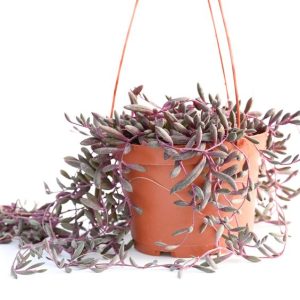Ruby Necklace Succulent

- Botanical Name: Othonna capensis 'Ruby Necklace'
- Family Name: Asteraceae
- Stems: 2-6.6 inch
- Temperature: 18°C – 27°C
- Other: Drought-resistant, sun-loving, adaptable.
Overview
Product Description
Morphological Characteristics
Ruby Necklace Succulent, scientifically known as Othonna capensis ‘Ruby Necklace’, is a succulent plant with unique charm. It features drooping, ruby-like purplish-red stems and green, fleshy, bean-shaped leaves that turn a striking purplish-red when subjected to moderate pressure. The plant is named for its necklace-like arrangement of string-like leaves and is a very popular choice for hanging or rockery plants.
 Growth Habits
Growth Habits
Ruby Necklace is native to South Africa and is a tropical succulent. It thrives in environments with plenty of sunlight, requiring at least six hours of light per day. Indoors, it should be placed in the brightest spots, especially near south or west-facing windows. This plant is drought-tolerant and does not appreciate frequent watering, preferring to be watered only when the soil is completely dry.
Adaptive Environment
Ruby Necklace has a strong adaptability and can tolerate the temperature and humidity levels of most households. Its ideal growing temperature range is between 65°F and 80°F (about 18°C – 27°C), and it should be protected from extreme heat or cold. This plant is not cold-hardy, so in winter it should be moved indoors to a sunny location and watered less frequently to keep the soil dry.
Care Instructions
When caring for Ruby Necklace, consider the following points:
- Light: It requires ample sunlight but should be shielded from direct exposure during the hot summer months.
- Watering: Moderate watering is appropriate during the growing season, but overwatering should be avoided as the plant is very drought-resistant.
- Soil: Well-draining soil is necessary, typically using a soil mix specifically formulated for succulents.
- Fertilization: During the growing season, a small amount of low-nitrogen fertilizer can be applied, but not in excess.
- Propagation: Propagation can be done through stem cuttings, ensuring that the cut parts dry out and form a callus before being planted in the soil to promote root growth.
Ruby Necklace is a very low-maintenance plant, suitable for busy modern lifestyles, and can add a splash of vibrant color to indoor or outdoor environments.










